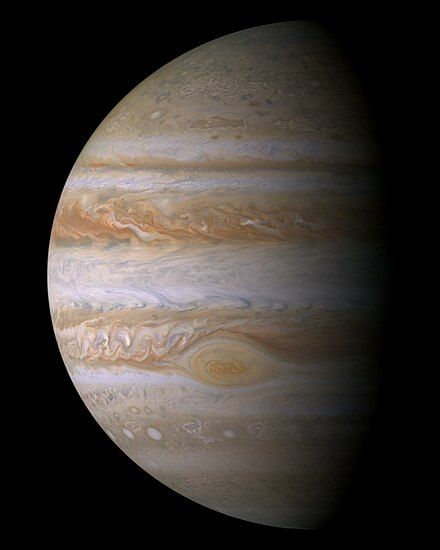
El Sistema Solar es el sistema gravitacionalmente ligado al Sol y los objetos que lo orbitan. Se formó hace 4.600 millones de años cuando una densa región de una nube molecular colapsó, formando el Sol y un disco protoplanetario . El Sol es una estrella ordinaria de secuencia principal que mantiene un equilibrio mediante la fusión de hidrógeno en helio en su núcleo , liberando esta energía de su fotosfera exterior .
Los objetos más grandes que orbitan alrededor del Sol son los ocho planetas . En orden a partir del Sol, se encuentran cuatro planetas terrestres ( Mercurio , Venus , Tierra y Marte ); dos gigantes gaseosos ( Júpiter y Saturno ); y dos gigantes de hielo ( Urano y Neptuno ). Todos los planetas terrestres tienen superficies sólidas. Por el contrario, todos los planetas gigantes no tienen una superficie definida, ya que están compuestos principalmente de gases y líquidos . Más del 99,86% de la masa del Sistema Solar se encuentra en el Sol y casi el 90% de la masa restante se encuentra en Júpiter y Saturno.
Existe un fuerte consenso entre los astrónomos de que el Sistema Solar tiene al menos ocho planetas enanos : Ceres , Plutón , Haumea , Quaoar , Makemake , Gonggong , Eris y Sedna . Hay una gran cantidad de pequeños cuerpos del Sistema Solar , como asteroides , cometas , centauros , meteoroides y nubes de polvo interplanetarias . Algunos de estos cuerpos se encuentran en el cinturón de asteroides (entre la órbita de Marte y Júpiter) y en el cinturón de Kuiper (justo fuera de la órbita de Neptuno). Seis planetas, seis planetas enanos y otros cuerpos tienen en órbita satélites naturales , a los que comúnmente se les llama 'lunas'.
El Sistema Solar está constantemente inundado por las partículas cargadas del Sol , el viento solar , formando la heliosfera . Alrededor de 75 a 90 unidades astronómicas , el viento solar se detiene y se produce la heliopausa . Este es el límite del Sistema Solar con el espacio interestelar . La región más exterior del Sistema Solar es la teorizada nube de Oort , la fuente de los cometas de período largo , que se extiende entre 2.000 y 200.000 unidades astronómicas (0,032 a 3,2 años luz ). La estrella más cercana al Sistema Solar, Próxima Centauri , está a 4,25 años luz de distancia. Ambas estrellas pertenecen a la Vía Láctea . ( Articulo completo... )





Sistema Solar : Planetas ( Definición · Habitabilidad planetaria · Planetas terrestres · Gigantes gaseosos · Anillos ) · Planetas enanos ( Plutoides ) · Colonización · Cronología del descubrimiento ˑ Exploración · Lunas · Planetarios
Se presentan artículos en negrita . Los artículos
en cursiva se refieren a planetas enanos o lunas importantes.
Los siguientes proyectos hermanos de la Fundación Wikimedia brindan más información sobre este tema: